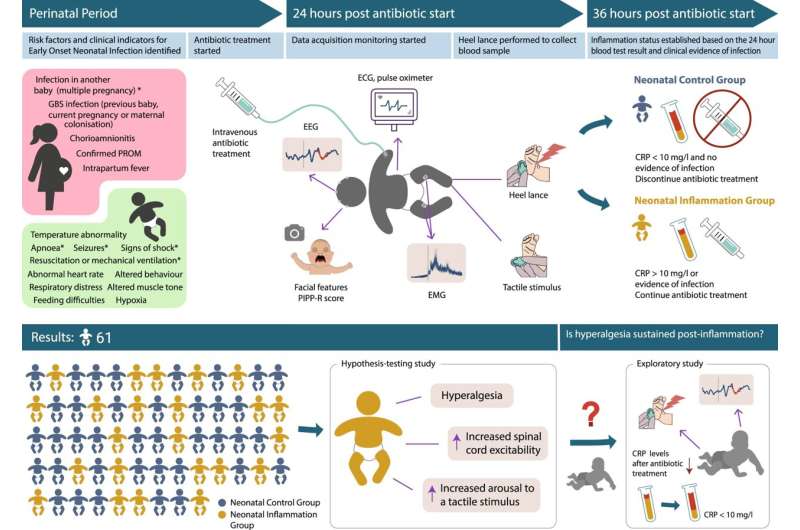Study design and main results. *Red flag risk factors and clinical indicators for Early-Onset Neonatal Infection (EONI). Antibiotic treatment was started if any red flag or two or more non-red-flag risk factors or clinical indicators were identified. See ref.18 for the complete National Institute for Health and Care Excellence (NICE) EONI screening guidelines in place during the study period. GBS Group B Streptococcus, PROM premature rupture of membranes, EEG electroencephalography, PIPP-R premature infant pain profile-revised, EMG electromyography, ECG electrocardiogram, CRP C-reactive protein. Credit: Nature Communications (2022). DOI: 10.1038/s41467-022-31505-y
In a new study published in Nature Communications, researchers observed 65 newborn babies who had received a standard heel-prick blood test to look for signs of potential infection. When a baby's blood test result suggested they may have an infection, which required further antibiotic treatment, the researchers continued to look for signs of pain or discomfort.
They found that babies with laboratory markers of inflammation associated with infection (raised C-Reactive Protein, (CRP) levels in blood) displayed more sensitivity to pain. This was measured by recording changes in each baby's brain activity, leg reflex withdrawal activity, facial expression and heart rate in response to a clinically-required heel prick blood test.
These babies were also more sensitive to touch, which is consistent with clinical reports that infections can make babies more irritable. While behavioral signs of pain, such as facial grimacing, did not appear to be exaggerated by the presence of inflammation, this may be because fighting an infection can cause babies to be more lethargic and fatigued.
This study also suggests that increased pain sensitivity may be maintained after the infection has been treated, supporting other laboratory studies which show that early-life infection can have a long-term influence on pain sensitivity that lasts into adulthood.
Rebeccah Slater, Professor of Pediatric Neuroscience and Senior Wellcome Fellow at Oxford University's Department of Pediatrics, said, "Around ten percent of babies are thought to have infections after birth, and it is important to realize that these babies may be more sensitive to pain when they are handled and cared for in hospital. As babies can't tell us when they are feeling pain finding ways to measure pain, including looking at their brain activity, is essential to improving clinical care."
Dr. Maria Cobo, the postdoctoral researcher who led the study, said, "It is thought-provoking to know that increased sensitivity to pain appears to last longer than the infection, highlighting the importance of constantly reviewing and improving the care we give to newborn children. Knowing that babies with infections may be more pain sensitive will encourage physicians to make babies more comfortable while they undergo treatment for common infections, which is important for both babies and their parents."
More information: Maria M. Cobo et al, Early life inflammation is associated with spinal cord excitability and nociceptive sensitivity in human infants, Nature Communications (2022). DOI: 10.1038/s41467-022-31505-y
Journal information: Nature Communications
Provided by University of Oxford























